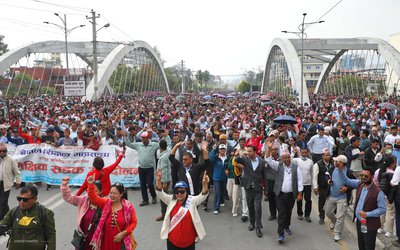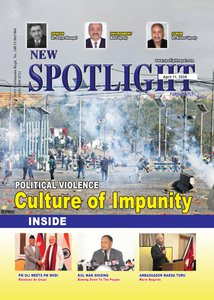
Results-based Evaluation in Action: Turning Development Challenges into Measurable Impact
Development projects require robust monitoring and evaluation frameworks to measure their effectiveness, efficiency, and sustainability. Approaches like results-based evaluation (RBE), the theory of change (ToC), and participatory impact assessment provide structured methodologies to assess impacts. Methods such as surveys, key informant interviews, focus group discussions, and counterfactual analysis (including randomized control trials) help establish causality and validate outcomes. RBE stands out because it directly links interventions to measurable change and moves beyond assessing outputs to assessing real impact. Its emphasis on evidence-driven decision-making strengthens accountability and enables organizations to refine strategies to make their programs more sustainable and impactful. Emerging in the 1990s within the results-based management framework, RBE was championed by global institutions like the UN, World Bank, and Organization for Economic Co-operation and Development-Development Assistance Committee ((OECD-DAC) to enhance accountability and the measurement of impact. These agencies employ RBE to measure the results in development and humanitarian programs. The EU and GEF use RBE to evaluate aid and environmental outcomes. Asian Development Bank (ADB) and African Development rely on RBE for infrastructure, economic growth, and poverty reduction, ensuring data-driven decisions and lasting impact. These agencies employ RBE to maintain transparency, improve decision-making, and ensure development initiatives deliver lasting and tangible results.
Implementing RBE well has several challenges, including defining clear, measurable results and balancing short-term gains with long-term impact. Overreliance on quantitative data can result in neglect of qualitative insights, and poor data complicates making an accurate assessment. Stakeholder disengagement, high turnover, and poor institutional dynamics can weaken continuity, while resistance to change and resource constraints add further obstacles. In addition, the pressure to meet targets can create a compliance-driven mindset rather than the adaptive, learning-focused approach associated with RBE.
Global Wins with RBE: Bolstering Accountability and Lasting Impact
Recent best practices in RBE emphasize the need to cultivate a learning culture rather than focus solely on compliance, a focus that ensures accountability while also driving continuous improvement. Organizations can strengthen the demand for results by encouraging managers to actively integrate data into decision-making. Effective RBE systems motivate performance through incentives, empower managers with autonomy in decision-making, and establish realistic accountability frameworks. Top-quality evaluations, particularly those which assess contributions to the SDGs, are high priorities, meaning that RBE can play a pivotal role in shaping impactful development initiatives. Notable global practices demonstrate how agencies such as the UN, the World Bank, and OECD-DAC have applied RBE across diverse regions. UNDP tracked sustainable development in Nepal and the Philippines, while the World Bank assessed economic reforms and poverty reduction in India and Kenya. OECD-DAC promoted RBE in donor-funded programs worldwide, a policy that ensured the effectiveness of aid, while the World Food Program and ADB used RBE to evaluate food security and infrastructure projects in Ethiopia and the Philippines, respectively, thereby enhancing both accountability and long-term impact. These are only a few examples.
Cracking the Code: Tackling Challenges and Elevating Evaluation Quality for Real Impact
Difficulty in defining clear and measurable results: A key challenge for RBE is defining clear and measurable results as many programs have complex, long-term objectives that do not easily align with quantifiable indicators. Projects often have to rely on proxy measures that fail to fully capture the intended impact, thus resulting in inconsistencies in the interpretation of data and weakening the credibility of evaluations. Organizations address this challenge by adopting SMART criteria and a participatory approach which gets stakeholders to set realistic, context-specific indicators. Instead of vague goals like “improve education,” agencies can craft specific measures such as “increase people’s literacy by 20% in two years.” Engaging stakeholders early ensures goals match local needs, while baseline data—like pre- and post-project literacy scores—makes progress easy to track. Using a ToC framework also helps break long-term goals down into measurable short-, medium-, and long-term outcomes. A balanced mix of quantitative and qualitative indicators ensures that the impact assessment will be comprehensive. For example, in India, UNICEF crafted precise, measurable outcomes to enhance education quality; in Kenya, the World Bank set clear, impactful benchmarks to guide infrastructure projects; and in Uganda, USAID combined both quantitative and qualitative indicators to deliver a comprehensive evaluation of the effectiveness of a health program. Regular capacity-building workshops can strengthen skill in developing indicators and interpreting data, while adaptive evaluation methods such as iterative learning and real-time feedback result in the refining indicators over time, enhancing the accuracy of evaluations.
Risk of focusing on short-term results at the expense of long-term impact: RBE frameworks often prioritize short-term, easily measurable outcomes, meaning that long-term impact might be neglected. This short-term focus also may discourage investment in programs with long gestation periods, such as capacity-building, institutional strengthening, and policy reforms. As a result, vital but slow-moving development efforts are often undervalued or discontinued due to the absence of immediate visible results. Organizations mitigate this risk by incorporating long-term impact indicators alongside short-term outcomes in their RBE frameworks. For example, by counting how many people are trained, agencies can track long-term changes like community behavior or system shifts. Embedding capacity-building, institutional strengthening, and policy reforms within the program’s ToC ensures their significance is recognized. Phased evaluation designs allow for both immediate and longitudinal assessments, so both quick and slower-moving impacts can be captured. For instance, Nepal focused on building lasting resilience and sustainable livelihoods in its disaster recovery efforts, while Kenya took a comprehensive approach by assessing both immediate outcomes and the long-term sustainability of its infrastructure projects. In the Philippines, the emphasis was on striking a balance between improving short-term healthcare access and fostering enduring improvements in health systems, effectively addressing the challenge of having short-term results prioritized over long-term impact. In this way, by integrating long-term objectives into funding and decision-making processes, organizations can secure sustained investments in programs with delayed but lasting outcomes.
Overemphasis on quantitative indicators in RBE: An overreliance on quantitative indicators in RBE often compromises the quality of evaluations by resulting in overlooking critical qualitative insights such as behavioral shifts, policy influence, and long-term social transformations. While numerical data does track progress, it fails to capture broad systemic changes, thereby leading to a narrow understanding of program effectiveness. This limitation risks producing an incomplete or misleading evaluation that does not fully reflect the true impact of an intervention. Organizations can address this challenge by adopting a mixed-method approach which combines quantitative metrics with qualitative insights from case studies, beneficiary feedback, and participatory assessments. Context-sensitive evaluation frameworks help capture complex social, behavioral, and policy changes that numbers alone cannot reflect. For example, in India, UNICEF seamlessly blended qualitative insights with quantitative data. In Kenya, USAID enriched its quantitative health data with in-depth qualitative interviews, and in the Philippines, the World Bank went beyond mere rates of infrastructure completion by incorporating vibrant case studies and stakeholder feedback to capture the full spectrum of impacts. Strengthening stakeholder engagement ensures a more holistic understanding of impact than mere numbers, while adaptive evaluation designs enable iterative learning and adjustments, enabling a project to balance measurable indicators with deep insights into long-term systemic change.
Poor-quality data and its impacts: Poor-quality data undermines the accuracy and reliability of the findings of project evaluations and can lead to erroneous conclusions about a project’s effectiveness and impact. Inaccurate, incomplete, or inconsistent data—such as unreliable baseline data or missing monitoring data—skews assessments and leaves critical outcomes unexamined. Gaps like these compromise the credibility of evaluations, reducing stakeholders’ confidence and undermining informed decision-making and the future allocation of resources. To address the challenges stemming from poor-quality data, an evaluation has to prioritize data verification and validation from the start, ensuring that it uses standardized data collection aligned with best practices. Triangulating data from multiple sources enhances reliability while training local teams in proper data management ensures consistency. Regular audits, participatory reviews, self-reflection exercises, mid-term reviews, and feedback mechanisms foster a culture of continuously improving data quality, addressing issues early and strengthening the overall evaluation process. Two sets of data should be assessed, indicator-wise progress data for a specific quarter or year and cumulative data from the beginning. This approach provides insight into gaps in particular indicators. For instance, in Nepal, UNDP partnered with local research institutions to boost the accuracy of data; in Kenya, the World Bank conducted on-the-ground field surveys and cross-referenced diverse data sources; and in Uganda, USAID harnessed mobile-based tools for data collection to ensure great reliability and precision.
The unwillingness of stakeholders to participate in the evaluation process and its impacts: The reluctance of stakeholders to allocate quality time to participating in evaluation interviews often stems from invisible institutional dynamics such as competing priorities, workload pressure, and limited understanding of either subject matters or the value of evaluations. The reluctance of stakeholders can hinder the evaluation process by leaving critical insights and feedback underrepresented and data incomplete or biased. As a result, the credibility of the conclusions will be compromised, and, without the engagement of key decision-makers, it is difficult to obtain accurate information on program impacts and therefore difficult to make informed recommendations for future improvements. To address this challenge, it is key to build strong relationships with stakeholders early in the evaluation process and to emphasize the value of their involvement, specifically the long-term benefits it offers for both the project and the communities it serves. Scheduling consultations in advance, offering flexible timings, and showing how the evaluation aligns with their goals helps ensure engagement. To overcome stakeholders’ reluctance to dedicate quality time to evaluation interviews, UNDP embraced flexible formats in Mongolia and Tajikistan and prioritized early engagement and tailored scheduling for maximum convenience in the Philippines. Streamlining the process to make it less time-consuming while still gathering the necessary information encourages participation. Fostering a culture of learning in which evaluations are seen as tools for improvement, not external scrutiny creates a supportive environment for active stakeholder involvement.
The reduction of institutional memory due to stakeholders’ turnover and its impacts: The frequent turnover of stakeholders during the design, implementation, and evaluation phases undermines institutional memory, creating gaps in continuity and reducing understanding of key project decisions. As individuals transition between roles or leave, valuable knowledge about the project’s context, challenges, and successes is lost. The frequent change of stakeholders can lead to miscommunication, misalignment of objectives, and inconsistent implementation. It can also complicate the evaluation process. New stakeholders often struggle to grasp the historical context behind past decisions, misunderstanding that hinders long-term project success and potentially leads to missed opportunities and repeated mistakes. To tackle these challenges, organizations make project documentation such as progress reports and decision logs accessible. Holding regular knowledge-sharing sessions and debriefings facilitates the transfer of knowledge from departing stakeholders to new team members. Clearly describing roles and responsibilities, and having a strong handover process ensures that transitions are smooth. Fostering a culture of institutional learning in which lessons are consistently documented and shared helps preserve valuable institutional memory despite turnover. Countries like Fiji, Myanmar, Bhutan, Cambodia, Indonesia, Sri Lanka, Thailand, China, and Vietnam, for example, implemented innovative strategies such as comprehensive documentation systems, inclusive stakeholder engagement, and mentorship programs to ensure seamless continuity and safeguard valuable knowledge.
Organizational resistance to change: Organizational resistance to change poses a significant challenge when shifting from traditional evaluation methods to results-based systems. Adopting RBE requires a shift in mindset, commitment by leaders, and openness to new methodologies, but many institutions fear increased pressure to be accountable. This fear may result in a reluctance to report failures or unintended consequences, which, in turn, may result in the selective reporting of data or the manipulation of results to meet donor expectations, ultimately distorting whatever evaluation is arrived at. To overcome organizational resistance to adopting RBE, organizations should foster a culture of learning and transparency; they need to present evaluations as tools for improvement, not just accountability. Strong leadership championing RBE and communicating its benefits is crucial. Capacity-building and training in change management help staff adapt to new methodologies and ease fears centered on an increase in accountability. Creating safe spaces for honest reporting and learning from failures can reduce the temptation to manipulate results and incentivize performance-based evaluation practices. Recognition and rewards, for example, can motivate staff to embrace RBE as a valuable decision-making tool. Countries like Solomon Islands, Nepal, India, Bangladesh, Afghanistan, Federated States of Micronesia, Lao People’s Democratic Republic, and Pakistan, to cite a few, took proactive steps by involving senior leaders, encouraging open dialogue, and bringing in external facilitators to build, support, and drive the adaptation of programs to incorporate valuable insights regarding evaluation.
Resource constraints: Resource constraints severely impact the effectiveness of RBE, especially in developing contexts where inadequate financial, human, and technical resources hinder the implementation of comprehensive evaluation systems. Limited national capacity and insufficient analytical expertise among evaluators continue to undermine the effectiveness of RBE. A lack of trained personnel, limited tools for collecting data, and insufficient funding can result in evaluations being poor quality and therefore having limited value for decision-making. Without adequate resources, RBE runs the risk of becoming a mere box-ticking exercise rather than a meaningful tool for learning and continuous improvement. To overcome the challenges posed by resource constraints, agencies adopt flexible approaches and methods to gather data and evidence. In Nepal, UNDP partnered with local academic institutions to carry out cost-effective research; in Kenya, USAID used mobile technology to collect data in remote areas; and in the Philippines, the World Bank adopted a phased approach to prioritize key areas and maximize limited resources.
Paving the Path Ahead: Turning Insights into Action
To maximize the transformative potential of RBE, organizations must move beyond perfunctory assessments and embrace a results-driven culture grounded in strategic clarity. A well-defined ToC functions as a dynamic roadmap, seamlessly connecting inputs to tangible, measurable impacts while aligning with broad development objectives. Establishing SMART indicators enables precise tracking of progress and reinforces evidence-based decision-making. Meaningful stakeholder engagement, particularly with beneficiaries and local partners, ensures that evaluation frameworks capture the complexities of real-world challenges and remain responsive to evolving needs. A robust monitoring system, integrating both quantitative metrics and qualitative insights, offers a comprehensive, multidimensional perspective on program effectiveness. At the same time, continuous capacity-building for staff and evaluators, combined with adaptive management strategies, fosters an environment in which learning translates into real-time improvements. Cultivating a culture of transparency and accountability in which results are not just reported but used to actively shape decision-making enhances both the credibility and impact of RBE.
A significant barrier to effective RBE is that it is frequently reduced to a compliance-driven exercise rather than a learning-oriented process. When evaluations prioritize bureaucratic reporting over genuine analysis, organizations squander opportunities to refine strategies, allocate resources effectively, and drive meaningful change. Low-quality evaluations not only erode credibility but also lead to misguided policies and inefficient interventions. Addressing these shortcomings requires a fundamental shift, one that integrates rigorous quantitative analysis with qualitative depth, strengthens institutional capacity to evaluate, and places continuous learning at the heart of decision-making. Clearly defined, context-sensitive indicators developed in collaboration with key stakeholders help ensure that evaluations reflect both immediate achievements and long-term transformations. Embracing mixed-method approaches which combine surveys, performance indicators, case studies, and in-depth interviews, yields a rich, holistic understanding of change dynamics, one that captures behavioral shifts, institutional reforms, and policy influences that numbers alone do not reveal.
Sustaining progress in RBE demands an unwavering commitment to data integrity, methodological excellence, and adaptive learning. Standardized data collection protocols, rigorous validation measures, and the triangulation of diverse sources are vital to ensuring accuracy and reliability. Strengthening local capacity not only enhances data ownership but also fosters a decentralized, context-driven approach to evaluation. Institutionalizing adaptive learning through continuous feedback loops enables organizations to refine strategies in real-time, ensuring that insights translate into action. Overcoming resource constraints requires adopting innovative approaches such as leveraging mobile technology for cost-effective data collection, forging partnerships with research institutions to derive deep analytical insights, and diversifying funding sources to sustain high-quality evaluations. By embedding these principles and practices into RBE systems, organizations can transform evaluation from a passive reporting mechanism into a powerful, insight-driven tool for accountability, impact, and long-term development success. Now is truly the moment to measure the effectiveness of aid while also gauging the socio-economic transformation needed to build resilient societies that will prosper both now and in the future.
Dr. Dhruba Gautam is an independent evaluator and researcher specializing in natural resource management, climate resilience, and disaster risk reduction across the Asia-Pacific and Caribbean regions. The insights in this article draw from his extensive meta-evaluations of disaster and climate-related projects in both regions. For collaborations or inquiries, he can be reached at drrgautam@gmail.com.
Mr. Dinesh Bista is a results-driven M&E expert with over 20 years of experience in designing and managing results-based systems within humanitarian and development sectors. With a proven track record in project management, he brings extensive expertise in research, collaborating across government, NGOs, the private sector, academia, and UN agencies. He can be reached at bista.dinesh@gmail.com.















